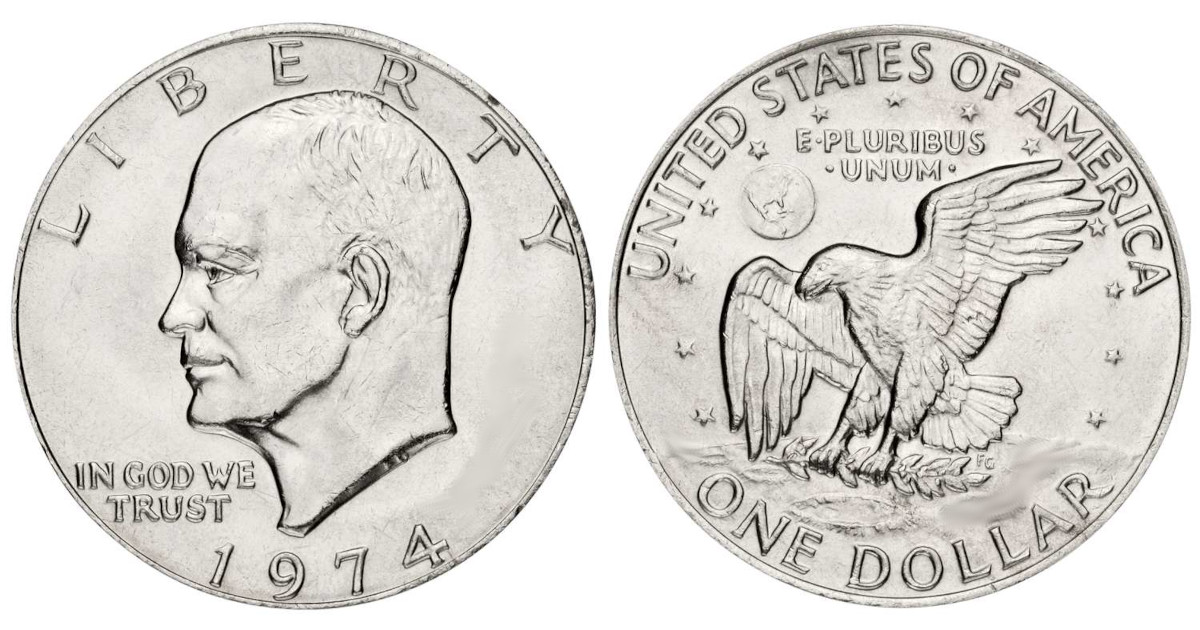
Coin Snapshot
- Weight: 22.68 grams
- Composition: Copper-nickel clad or 40% silver (special issues)
- Diameter: 38.1 mm
- Thickness: 2.58 mm
- Years Minted: 1971-1978
- Designed by: Frank Gasparro
- Total Coins Struck: Over 692 million (combined mintages of clad and silver issues)
Brief Overview of Eisenhower Dollars
The Eisenhower Dollar, introduced in 1971, is an iconic coin that commemorates two significant figures in American history: President Dwight D. Eisenhower and the Apollo 11 Moon landing. Named after the 34th President of the United States, Eisenhower, the coin became the first U.S. dollar minted since the Peace Dollar series ended in 1935. Frank Gasparro designed both sides of the coin, featuring a portrait of Eisenhower on the obverse and an eagle landing on the moon on the reverse, symbolizing the successful lunar landing in 1969.
Although the Eisenhower Dollar was only produced for circulation until 1978, its bold design, historical significance, and large size make it a favorite among collectors. Unlike earlier silver dollar coins, most Eisenhower Dollars were struck in copper-nickel clad, though special 40% silver issues were produced for collectors. Despite its relatively short minting period, the Eisenhower Dollar remains an important coin in modern U.S. numismatics.
Obverse Design
The obverse of the Eisenhower Dollar, designed by Frank Gasparro, features a striking profile of President Dwight D. Eisenhower. The design was inspired by his role as a five-star general during World War II and his presidency from 1953 to 1961. The inscription “LIBERTY” appears at the top, while the motto “IN GOD WE TRUST” and the year of minting are placed below Eisenhower’s portrait. Gasparro’s initials, “FG,” can also be found on the obverse near Eisenhower’s neckline.
This design represents one of the few U.S. coins to honor a 20th-century president, reflecting Eisenhower’s enduring legacy as a military leader and statesman. The obverse is also notable for its simplicity and clarity, with Eisenhower’s face taking center stage on the large coin.
Reverse Design
The reverse design of the Eisenhower Dollar pays tribute to the Apollo 11 Moon landing, with a bold image of an eagle clutching an olive branch as it lands on the moon’s surface. This design was adapted from the official Apollo 11 mission patch and serves as a symbol of both peace and the United States’ achievements in space exploration. The Earth can be seen in the background, highlighting the coin’s celebration of human progress and exploration.
The reverse also features the inscriptions “UNITED STATES OF AMERICA” along the top and “E PLURIBUS UNUM” just above the eagle. The denomination “ONE DOLLAR” is placed at the bottom. This design struck a balance between commemorating the Apollo 11 mission and showcasing the country’s national symbol—the bald eagle.
Mint Locations and Mintmarks on the Eisenhower Dollar
The Eisenhower Dollar was minted at three key locations: Philadelphia, Denver, and San Francisco. Each mint produced both circulation coins and special collector issues, with certain mintmarks signifying the location where the coin was struck.
- Philadelphia Mint: Coins minted in Philadelphia do not bear a mintmark, though the facility produced a large number of Eisenhower Dollars for circulation, as well as special issues.
- Denver Mint: Eisenhower Dollars struck in Denver feature the “D” mintmark. This mint produced the majority of circulation strikes during the coin’s production period.
- San Francisco Mint: The San Francisco Mint produced Eisenhower Dollars primarily for collectors, including special 40% silver issues. Coins from San Francisco feature the “S” mintmark.
While most Eisenhower Dollars were struck in copper-nickel clad composition for circulation, collectors can also find 40% silver examples produced at the San Francisco Mint. These special issues, known as “blue” or “brown” Ikes (depending on packaging), are prized for their silver content and collector appeal.
History of the Eisenhower Dollar
The Eisenhower Dollar was first authorized in 1970, following the passing of legislation to honor President Dwight D. Eisenhower, who had passed away in 1969. The U.S. Mint also sought to commemorate the Apollo 11 Moon landing, which occurred in the same year. This dual-purpose coin was intended to serve as a tribute to both events, reflecting a period of American pride in its leadership and technological achievements.
Before the Eisenhower Dollar, the U.S. Mint had not produced a circulating dollar coin since the Peace Dollar ended in 1935. The Eisenhower Dollar represented a return to larger coins, though it was not struck in the traditional 90% silver composition. Most Eisenhower Dollars minted for circulation were composed of copper-nickel clad, while the special collector issues were struck in 40% silver.
The production of the Eisenhower Dollar ended in 1978, as the large size of the coin and its low circulation popularity led to its discontinuation. Despite being withdrawn from everyday use, the Eisenhower Dollar remains a symbol of the technological achievements of the 1960s and the legacy of President Eisenhower.
Eisenhower Dollar Prices
The value of an Eisenhower Dollar depends on several factors, including its composition, year, mintmark, and condition. Circulation strikes in copper-nickel clad are generally affordable and can be found for a modest premium above face value, especially in lower grades. However, Eisenhower Dollars minted in 40% silver or in mint state condition can be more valuable, particularly for collectors looking for high-grade examples.
Special issues, such as the 1971-S and 1972-S proof coins struck in 40% silver, are highly sought after due to their silver content and limited production. Similarly, coins graded by third-party services like PCGS or NGC in grades of MS65 and higher can fetch higher prices due to their condition and rarity.
Among the most valuable Eisenhower Dollars are the Type 2 1972 Philadelphia strikes, which feature a rare reverse variety with a different depiction of the Earth. This coin is a notable variety and commands a significant premium in higher grades.
Examples of Rare and Expensive Eisenhower Dollars
Several Eisenhower Dollars stand out as rare and more expensive, particularly when they feature unique varieties or are in high-grade condition. Some of the most notable examples include:
- 1972 Type 2 Eisenhower Dollar: This variety, struck at the Philadelphia Mint, features a rare reverse design showing a more detailed depiction of the Earth. These coins are valuable, especially in higher grades.
- 1971-S and 1972-S Silver Proof Eisenhower Dollars: Coins struck in 40% silver for collectors. These proof issues are prized for their silver content and sharp strikes, particularly in higher grades.
- 1976 Bicentennial Eisenhower Dollar: Struck to celebrate America’s bicentennial, these coins feature a dual date (1776-1976) and a special reverse design showing the Liberty Bell and the Moon. Silver-clad examples from the San Francisco Mint are highly sought after.
Eisenhower Dollar Condition and Certification
As with most coins, the condition of an Eisenhower Dollar plays a critical role in its value. Coins in mint state (MS) condition, particularly those graded MS65 or higher by services like PCGS or NGC, are highly collectible. The large size of the Eisenhower Dollar makes it prone to surface marks and wear, so well-preserved examples are rare and more valuable.
Proof Eisenhower Dollars, especially those struck in 40% silver, are also popular with collectors. These coins feature deep mirrors and frosted devices, making them visually striking. Certified proof coins in high grades are especially desirable, particularly for special issues like the 1976 Bicentennial silver proofs.
Buying Eisenhower Dollars Online
Eisenhower Dollars are readily available to collectors through a variety of sources, including online auctions, coin dealers, and coin shows. Due to their relatively recent production, many Eisenhower Dollars remain in good condition and can be found at reasonable prices. However, collectors should be aware of the differences between circulation strikes and special collector issues, such as the 40% silver proofs from San Francisco.
When purchasing Eisenhower Dollars online, it’s advisable to seek out certified coins graded by PCGS or NGC to ensure authenticity and accurate grading. This is particularly important for higher-grade coins or rarer varieties, such as the 1972 Type 2 Eisenhower Dollar. Coins from reputable sellers and auction houses are generally a safe bet for building a high-quality collection.
Eisenhower Dollars also make an excellent entry point for new collectors due to their historical significance and affordability. Whether you’re interested in building a complete set of clad issues or focusing on special silver proofs, the Eisenhower Dollar series offers a range of options for collectors at all experience levels.
